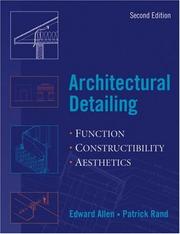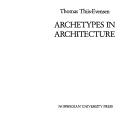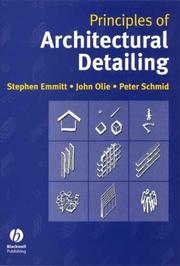| Listing 1 - 10 of 49 | << page >> |
Sort by
|
Book
ISBN: 3034608543 9783034608541 9783764399863 3764399864 Year: 2010 Publisher: Basel : London : Birkhauser ; Springer [distributor],
Abstract | Keywords | Export | Availability | Bookmark
 Loading...
Loading...Choose an application
- Reference Manager
- EndNote
- RefWorks (Direct export to RefWorks)
Dass dynamische Bauteile und adaptive Bauelemente in der aktuellen Architektur an Bedeutung gewinnen, geschieht nicht nur des visuellen Effekts wegen. Wenn Architekten und Ingenieure sich immer mehr mit dem Thema Bewegung - sei es beispielsweise als nachgeführte Solarzelle, als versenkbare Wand oder als intelligent programmierter Aufzug - auseinandersetzen, dann erkunden sie Lösungen für drei Herausforderungen: Wie können wir den Energiebedarf von Gebäuden kontrollieren und reduzieren? Wie können wir die Nutzungsmöglicheiten erweitern? Und wir können wir dynamische Bewegungen in Gebäuden abbilden, aufnehmen und lenken? Entwerfer und Konstrukteure finden sich durch kinetische Bauteile vor neue technische und gestalterische Herausforderungen gestellt, die in der traditionellen Baukonstruktionslehre nicht behandelt werden. Für diese Anwender zeigt das Buch, mit welchen technischen Mitteln und konstruktiven Lösungen die Bewegungen konkret umgesetzt und in den Bereichen "Energie", "Nutzungsänderung" und "Interaktion" funktional eingesetzt werden können. Zuvor werden die Grundlagen und Gestaltungsprinzipien der Kinetik in Architektur, Technik, Kunst und Natur strukturiert aufbereitet. In einem dritten Teil werden auf jeweils einer Doppelseite vierzig bewegliche Bauelemente an ausgeführten Bauten in Aktion gezeigt - mit eigens erstellten Phasenzeichnungen und gegliedert nach Bewegungstypen wie Drehen, Schieben, Falten und Verformen. Die internationalen Beispiele namhafter Architekten reichen von Fenstermechanismen über Sonnenschutz- und Lichtlenkungssysteme und bewegliche Wände und Dächer bis hin zu beweglichen Ingenieurbauwerken. Dynamic components and adaptive elements are becoming increasingly important in contemporary architecture, and not just because of their visual effect. If architects and engineers are engaging more and more with the issue of movement - whether in the form of sun-tracking solar cells, lowerable walls, or intelligently programmed elevators - it's because they are busy exploring responses to three challenges: How can we control and reduce the energy requirement of buildings? How can we expand the range of possible uses? And how can we represent, illustrate, accommodate, and control dynamic movements in buildings? Designers and builders who seek to use kinetic components face technical and design challenges that aren't covered by traditional structural theory. For these users, this book presents the technical tools and constructional solutions that will allow them to implement these movements concretely and deploy them functionally within the domains of of "Energy," "Change of Use," and "Interaction." First it lays out the fundamentals and design principles of kinetics in architecture, technology, art, and nature in a structured manner. In a third section, forty movable elements are shown in action, each on a double page - with specially prepared phase drawings and organized by type of movement, including rotation, sliding, folding, and transformation. The international examples from noted architects range from window mechanisms to solar protection and light redirection systems, movable walls and roofs, and movable civil engineering structures.
Motion in architecture. --- Architecture --- Architectural details --- Buildings --- Details, Architectural --- Architectural design --- Architectural drawing --- Details. --- Details

ISBN: 9780471488170 0471488178 Year: 2007 Publisher: Hoboken (N.J.) Wiley
Abstract | Keywords | Export | Availability | Bookmark
 Loading...
Loading...Choose an application
- Reference Manager
- EndNote
- RefWorks (Direct export to RefWorks)
Architecture --- 69 --- 72.04 --- Architectural details --- Buildings --- Details, Architectural --- Architectural design --- Architectural drawing --- Details --- Bouwtechniek --- Architectuurdetails --- Details (architectuur)
Book
ISBN: 1281968625 9786611968625 1607503697 1441601589 6000011873 1597343919 9781441601582 9781607503699 158603913X 9781586039134 9781597343916 9781586039134 9781281968623 6611968628 9786000011871 Year: 2008 Publisher: Amsterdam : IOS Press,
Abstract | Keywords | Export | Availability | Bookmark
 Loading...
Loading...Choose an application
- Reference Manager
- EndNote
- RefWorks (Direct export to RefWorks)
""Understanding Meaningful Environments: Architectural Precedents and the Question of Identity in Creative Design"" intends to put forward a discussion on the use of precedents and the production of innovative designs as well as to discuss the relationship between precedents and identity in a world undergoing a rapid process of globalization. This publication provides insights into how the strategy of making use of design precedents as a source of knowledge rather than initiating a project from tabula rasa leads to efficient, effective, and/or innovative results, based, in particular, on the w
Architectural design. --- Architecture --- Architectural details --- Buildings --- Details, Architectural --- Architectural design --- Architectural drawing --- Design --- Structural design --- Details. --- Details
Book
ISBN: 1443875740 9781443875745 1336096802 9781336096806 1443872563 9781443872560 Year: 2015 Publisher: Newcastle upon Tyne, England : Cambridge Scholars Publishing,
Abstract | Keywords | Export | Availability | Bookmark
 Loading...
Loading...Choose an application
- Reference Manager
- EndNote
- RefWorks (Direct export to RefWorks)
Definitions of space are as diverse as the disciplines in which it plays a fundamental role; from science and philosophy to art and architecture, each field's perception of space is often simplified or reduced. This consequently denies access to 'new spaces', whose definitions and perspectives, strategies and impacts on human perception are rarely considered in any cohesive manner. This is where the Aedes Network Campus Berlin (ANCB) programme 'No Space Without Traits' came in: particularly through artistic approaches, it aimed to open doors into spatial worlds that until now have remained closed. The symposium 'PERCEPTION in Architecture. HERE and NOW' was part of this programme and invited critical and comprehensive contributions by academics, artists, architects, designers and curators. These presentations are brought together in this volume to reflect upon new spatial concepts and thus access 'new spaces' of perception in architecture. The symposium stimulated a discourse focused on spaces as a collective entity, notions of spatial truth, the multiplicity of experience, and Wahrnehmnungsapparate, as well as physical, visual, acoustic and virtual manifestations of space in relation to social, cultural, historical and political forces.
Architecture --- Architectural details --- Buildings --- Details, Architectural --- Architectural design --- Architectural drawing --- Environmental psychology --- Psychological aspects. --- Details. --- Details --- Human factors

ISBN: 8200077004 821504641X Year: 1987 Publisher: Scandinavian University Press (Universitetsforlaget)
Abstract | Keywords | Export | Availability | Bookmark
 Loading...
Loading...Choose an application
- Reference Manager
- EndNote
- RefWorks (Direct export to RefWorks)
This book develops a grammar for the basic elements in the art of building: the floor, the wall and the roof. Drawing on examples from the history of architecture, a range of archetypes connected to these basic elements are discussed. The book explores how these architectural archetypes affect us psychologically, with a particular emphasis on the relationship between archetypes and the dynamic interactions between inside and outside space. The book shows how our experiences of architecture are tied in with our bodily experiences of archetypes as carriers of specific meanings, which in turn influences our experiences of the relationship between inside and outside. The aim of the book is design-oriented. With more accurate knowledge of the archetypes and their variations, schematic post-war architecture can be replaced without necessarily resorting to copying motifs from the past.
Architecture --- Architectural design. --- Details. --- Architectural details --- Buildings --- Details, Architectural --- Architectural design --- Architectural drawing --- Design --- Structural design --- Details --- Archetypes

ISBN: 1405107545 9781405107549 Year: 2004 Publisher: Oxford : Blackwell,
Abstract | Keywords | Export | Availability | Bookmark
 Loading...
Loading...Choose an application
- Reference Manager
- EndNote
- RefWorks (Direct export to RefWorks)
"In Principles of Architectural Detailing the authors question the way in which buildings are detailed and, in particular, challenge familiar joint solutions. They offer practical guidance and a number of tools to help the student of architectural detailing in the decision-making process. The emphasis throughout is on using knowledge of construction in a creative and productive way to contribute towards a built environment that enhances our well-being and which is also sustainable."--Jacket.
Architecture --- Details. --- Environmental aspects. --- 72.04 --- Architectural details --- Buildings --- Details, Architectural --- Architectural design --- Architectural drawing --- Architectuurdetails --- Details (architectuur) --- Ornamenten (architectuur) --- Details --- Environmental aspects
Book
ISBN: 1280104937 0203439988 9780203439982 9786610104932 Year: 1997 Publisher: London ; New York : Routledge,
Abstract | Keywords | Export | Availability | Bookmark
 Loading...
Loading...Choose an application
- Reference Manager
- EndNote
- RefWorks (Direct export to RefWorks)
Analysing Architecture offers a unique 'notebook' of architectural strategies to present an engaging introduction to elements and concepts in architectural design. Beautifully illustrated throughout with the author's original drawings.
Architectural design. --- Architecture --- House and Home. --- Architectural design --- Art, Architecture & Applied Arts --- Design --- Structural design --- Architectural details --- Buildings --- Details, Architectural --- Architectural drawing --- Details. --- Details
Book
ISBN: 1139452991 1108054692 Year: 2013 Publisher: Cambridge : Cambridge University Press,
Abstract | Keywords | Export | Availability | Bookmark
 Loading...
Loading...Choose an application
- Reference Manager
- EndNote
- RefWorks (Direct export to RefWorks)
Sir William Chambers (1722-96), architect and furniture designer, wished to further his career in the 1750s by publishing on architecture. He also became the Prince of Wales' architectural tutor, architect to the office of works, then head of the royal works (comptroller and surveyor-general from 1782). Notably, he remodelled Buckingham House (1762-73) and designed Somerset House (1775-96), but Chambers' reputation rests also on his Treatise on Civil Architecture (1759), which he revised and expanded in 1791 as A Treatise on the Decorative Part of Civil Architecture. It is regarded as one of the standard English texts on classical architecture, and remains essential reading. This reissue is of the two-volume edition of 1825, annotated by the architect and writer Joseph Gwilt (1784-1863). Volume 1 includes Gwilt's prefatory material, including an analysis of Grecian architecture's development.
Architecture --- Decoration and ornament, Architectural. --- Details. --- Architectural decoration and ornament --- Stonework, Decorative --- Architectural design --- Exterior walls --- Architectural details --- Buildings --- Details, Architectural --- Architectural drawing --- Decoration and ornament --- Details
Book
ISBN: 3874225437 9783874225434 Year: 1975 Volume: 7 Publisher: Stuttgart: Alexander Koch,
Abstract | Keywords | Export | Availability | Bookmark
 Loading...
Loading...Choose an application
- Reference Manager
- EndNote
- RefWorks (Direct export to RefWorks)
Façade --- Procédé de construction --- Building --- Architecture --- Details --- -bouwkunde --- gevelbekleding --- Architecture, Western (Western countries) --- Building design --- Buildings --- Construction --- Western architecture (Western countries) --- Art --- Details. --- Design and construction --- bouwkunde --- Architectural details --- Details, Architectural --- Architectural design --- Architectural drawing --- Building - Details --- Architecture - Details

ISBN: 0486246051 Year: 1984 Publisher: Mineola Dover Publications
Abstract | Keywords | Export | Availability | Bookmark
 Loading...
Loading...Choose an application
- Reference Manager
- EndNote
- RefWorks (Direct export to RefWorks)
Architectuur ; details ; plannen ; onderdelen --- 72.04 --- Architectuur ; details, ornamenten, decoratie --- Architecture --- Composition, proportion, etc. --- Details. --- Architectural details --- Buildings --- Details, Architectural --- Architectural design --- Architectural drawing --- Proportion (Architecture) --- Composition (Art) --- Composition, proportion, etc --- Details --- Proportion
| Listing 1 - 10 of 49 | << page >> |
Sort by
|

 Search
Search Feedback
Feedback About UniCat
About UniCat  Help
Help News
News